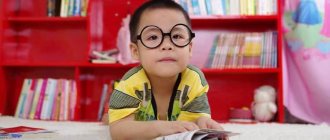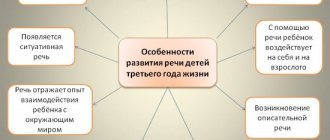Quite often, parents complain that children encounter problems pronouncing sounds that are difficult for them. As a rule, the greatest difficulty for them is hissing sounds; in particular, parents’ questions are related to how to teach a child to correctly pronounce the letters “s”, “k” and others. You need to pay attention to developing this skill in childhood.
The sound C is problematic in pronunciation
Despite the fact that most parents seek speech therapy help most often when the child is already 5 years old, most pediatricians agree that work on sound pronunciation should begin much earlier.
This will prevent the incorrect pronunciation of the sound from taking hold. To carry out such activities it is not at all necessary to have special skills - it is enough to learn only a few simple techniques.
Tips for pronouncing the C sound
Correct articulation and pronunciation disorders
Correct articulation C is similar to articulation I. Only the teeth are closed, the tongue is behind them and is located below, an air stream passes through its central part. The exhalation is strong and cold. If the organs of articulation take the wrong position, then a distortion of sound pronunciation results. Therefore, when diagnosing, a speech therapist pays attention to the state of articulation and speech breathing.
Incorrect pronunciation of a whistling group is called sigmatism, and their replacement in speech with others is called parasigmatism.
Main types of violation:
- The child has no sound in speech.
- Interdental - when a child says C, the tongue is between the teeth. A whistling sound appears with an overtone as in the word “that”. With this violation, the air stream is not cold, but warm.
- Lateral - during pronunciation, the tongue takes a side position or rises. The air stream is directed to the side, one corner of the lips may be lowered, and the gap between the teeth becomes larger.
- Nasal - with this type of sigmatism, a nasal sound is produced, more like an X. The articulation is as follows: the lips are not stretched in a smiling position, the tongue is moved deeper into the mouth, and the child exhales through the nose, which gives the sound a nasal tone.
Most often in speech, whistling sounds are replaced by hissing ones, and there may be voicing. In such cases, great attention should be paid to the differentiation stage.
First problems.
The first problems began while serving in the army. This was in 2011. At that time, there was a program on TV about Bearded Man, a security guard from a store. Remember? So, he lisped. I didn’t burr that much, but I could easily parody the Bearded Man. Many colleagues asked me to say: Alexandergggg Gggodionovich Boggodach. It was funny, I wasn’t offended by it, people made good jokes, but of course I was pretty tired of it.
But after the service, everything returned to normal and no one said anything about it. Well, maybe behind your back, as we like 
Reasons for violations
One of the reasons for the appearance of sigmatism is a violation of articulation. It may be due to anatomical features, for example, malocclusion. Then you need to visit an orthodontist. Or it could be the presence of adenoids that need to be removed.
Violations of sound pronunciation C can be caused by the following features of the articulatory apparatus:
- weak muscle tone of the tongue;
- tremor of the tip of the tongue.
The absence or impairment of pronunciation C may be a manifestation of dyslalia (simple and complex forms) or be part of more complex speech disorders: dysarthria, rhinolalia, alalia. Based on the cause of the violations, the speech therapist draws up a plan for corrective work.
A little introductory information from a burr with experience.
Burry people speak from their throats. I also spoke. This makes for a completely different sound. Just as the throaty R is unusual for you, the tongue-tip R is unusual for the burr. But it is not necessary to burr at all sounds, both hard and soft. I already talked about this above. I had practically no problems with R, as well as with L.
But this does not mean that R was easy. These sounds are pronounced completely differently. Like L and L. Do you think it’s possible to burr with L? It’s easy, try to pronounce it with your throat: press the root of your tongue to your upper jaw and try to say L. Yes, yes...
Speech therapy diagnostics
The speech therapist looks at the state of the articulatory apparatus: the state of the bite, the muscle tone of the tongue and lips. To do this, he asks the preschooler to perform exercises to maintain a certain position and dynamic tasks. In addition, the speech therapist evaluates speech breathing: watches how the baby inhales and exhales, asks to play the pipe.
To diagnose sound pronunciation, a specialist selects speech material in which C is at the beginning, middle and end of the word. In this case, there should be no mixed sounds in the words. This is the Z, C and hissing group. First, the speech therapist asks you to say the sound in isolation, then in syllables, words, phrasal speech and sentences. Then he asks the child to write a story or describe what is drawn in the picture and pays attention to how S sounds in ordinary speech.
Then they make a diagnosis of phonemic processes. The speech therapist names the sounds, and the child must do a certain action when he hears the right one. Gradually, the specialist complicates the speech material, naming syllables and words. Then the patient is asked to name the desired word from a pair of paronyms and select words with the desired sound from the list.
Based on diagnostic data, the speech therapist draws up a plan of correctional work. If the speech disorder is complex, then the child needs to be provided with comprehensive assistance. It includes the joint work of a speech therapist, neurologist, and defectologist.
We design.
We lay out the silhouettes of letters from counting sticks, matches, Lego and everything else that comes to hand:
Some children may find it difficult to form letters from available materials (especially if the child is under 3.5 years old).
With such children you can design using the “overlay” method.
To do this, you can draw these simple diagrams:
Also, in order to build letters, you can use the Zheleznovs’ musical primer, which was already written about in paragraph 3 of this article.
For example, the poems and song that are described in paragraph 3 for “A” can also be used to construct this letter from sticks (Tilt two sticks, connect them at the top, one crossbar - like the letter A in a tent!)
Preparatory stage
You can put C on your own at home if you do special exercises. Preparation for the performance consists of articulatory gymnastics and the formation of correct speech breathing. If the tongue's muscle tone is impaired, then massage is necessary. At the pharmacy you can purchase a special kit for speech therapy massage.
A child can do self-massage of the tongue:
- “Naughty tongue” - a wide tongue on the lower lip. The child says “pyapapapya”, but does not remove his tongue.
- The position of the tongue is similar, only now the child should bite it lightly - the tip and the middle.
In addition to this massage, at the preparatory stage they do a set of articulation exercises. The main position for the lips in all tasks is a smile, and the tongue occupies a lower position. Your task is to teach how to make your tongue wide and relaxed and hold it in this position below your teeth. A good exercise is “Mountain”: the tip of the tongue rests on the lower teeth, and its middle and side edges move forward - it turns out to be a hill.
In addition to gymnastics for the articulation apparatus, you need to develop a strong exhalation.
- "Who will score a goal." To do this you will need two small pieces of cotton wool and objects that will serve as gates. Stretch your lips with a straw, inhale through your nose and, as you exhale, blow out the cotton ball. When performing this exercise, the child should, without puffing out his cheeks, move the cotton wool in one exhalation.
- Do the same thing, only now your lips are in a smiling position, and your wide tongue is on your lower lip. The child blows off the cotton wool, pronouncing an extended F.
The preparatory stage is needed to form the basis for staging the correct pronunciation of S. Also, exercises for whistling are the basis for staging other groups of sounds. That is why, if the sound pronunciation of several groups is impaired, work begins with the whistlers.
"Find it!"
Find all the letters “K” in this picture and circle them!
And in this picture there are all the letters “T”:
Find all the red letters “M”... And now the blue ones... And now the orange ones, etc.
Now count - how many letters “M” did you find in total?
Staging methods
At home, adults can independently pronounce S. You can use the articulation I as a support. Ask the child to pronounce I for a long time several times, and then perform articulation and breathing exercises. There are two ways to set C:
- Ask your child to smile as if pronouncing I. The teeth should be together and the tongue should be behind them. Then the baby blows on the cotton wool in front of him. You may hear a slight whistle. The stronger the child exhales, the clearer the sound will be.
- Mechanical method - to perform it you will need a cotton swab. The starting position is the same as for articulation I. Only place the tip of a cotton swab in the middle of the tongue and press lightly to create a groove. The child blows on his tongue - you will hear S. Be sure to bring the back of your hand up: as you exhale, the stream turns out to be cold, strong and narrow.
The mechanical method can be used at the stages of automating isolated pronunciation and practicing sounds in syllables. When the articulation organs “remember” the desired position, the cotton swab can be removed.
Many parents ask: “How to teach a child to pronounce the letter C?” Sounds are introduced and letters are studied in literacy classes. A person hears and pronounces sounds, and reads and sees letters. This difference needs to be explained to the child so that it is easier for him to learn the sound analysis of the word.
Effective classes with a speech therapist starting with the letter C
A qualified speech therapist will not use methods that force a child to do something he does not want to do.
How does a sound production lesson work [C]
An experienced speech therapist's appointment consists of fun games, close to pampering, when a child, together with an adult, is allowed to make faces in front of the mirror and utter various funny syllables.
Individual lessons on audio automation [C]
Such exercises should be regular until the result is achieved. Mandatory exercises for the formation of the correct sound include a game of imitating the noise of a pump, a blizzard, or a deflating balloon.
In a family where adults take the trouble to communicate with the child once a day, not in a hurry, but thoughtfully, correcting the pronunciation they hear, the child will gradually begin to speak clearly in a natural environment. Care in the family, a healthy moral environment and an adequate assessment of abilities are the key to a successful and psychologically healthy child.
Recommendations for parents
Automation begins with isolated utterance, gradually complicating the speech material from syllables to independent compilation of stories based on the picture. At the beginning of work, speech should be as saturated with the sound C as possible, then gradually bring it closer to normal conversational speech. You can offer your child to learn short poems. Also, first choose words that do not have similar sounds in terms of acoustic characteristics.
In Russian, the sound C is a consonant that is unvoiced. Therefore, make sure that when pronouncing it, the child’s vocal cords do not work. To do this, place the back of your hand on the vocal cords - they should not vibrate. This feature will be useful to you if your child confuses S and Z. It is through tactile sensation that you can show him the difference between these sounds.
How quickly is correct pronunciation established and reinforced? The older you are, the longer the work may take. For example, for a teenager, the stage of automating sound in conversational speech may last longer, because incorrect pronunciation is more firmly entrenched than for a three-year-old child who is just mastering speech. Therefore, you need to engage in speech development from an early age, then your child’s speech will be correct and beautiful.
By the way, you were talking about L. What's with her?
I pronounced it wrong. That's all. As it turned out, you need to press the tip of your tongue against your teeth and try to pronounce the sound L. I spent 2-3 lessons on it + a couple of weeks at home to practice. As young people say: it was absolutely easy :)
But we trained her exactly the same way as R, no concessions. There were words with La, lu, le... and with Al, st, ate....
PS when I burred, I practically did not notice that some people also burred. I was on the same wavelength with them, now I notice.







